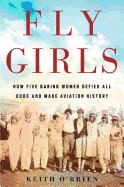
More than 80 years after Amelia Earhart's mysterious disappearance, she continues to hold a place among the world's most famous women. What isn't as well known is that Earhart was part of a group of brave, high-achieving and largely forgotten female pilots--fly girls--who helped to set the course of aviation while setting records and shattering stereotypes.
A fly girl is "a term used in the 1920s to describe female pilots and, more broadly, young women who refused to live by the old rules, appearing bold and almost dangerous as a result." In addition to Earhart, these fearless women included Florence Klingensmith, Ruth Elder, Louise Thaden and Ruth Nichols. They came from vastly different backgrounds: Nichols was born into a wealthy Rye, N.Y., family; Elder was a divorcée from Alabama; Thaden sold coal in Wichita, Kan. Yet each saw flying as a chance to prove that women could compete equally in a high-stakes, life-or-death environment. "These women... wanted the right to be heard and the right to hold any job they wished. Most of all, they wanted respect...."
Journalist Keith O'Brien's (Outside Shot) compelling narrative soars as he explores the business of competitive air races in the 1920s and '30s, complete with publicity-savvy promoters and wealthy investors who recognized that women pilots would generate intense interest, especially in cross-county events. As they competed in the face of tragedy and discrimination, the female pilots learned the importance of keeping a united front and supporting each other (they formed the Ninety-Nines, a female pilots' association still in existence). The bravery, courage and determination of the fly girls provides inspiration for modern times. --Melissa Firman, writer, editor and blogger

